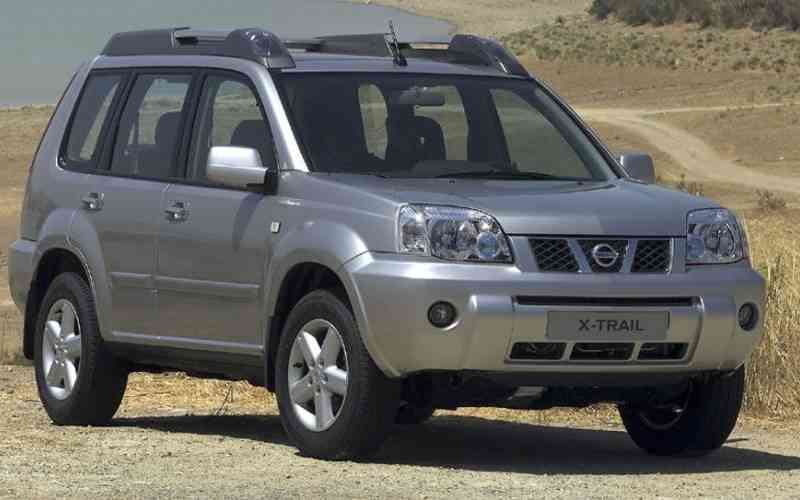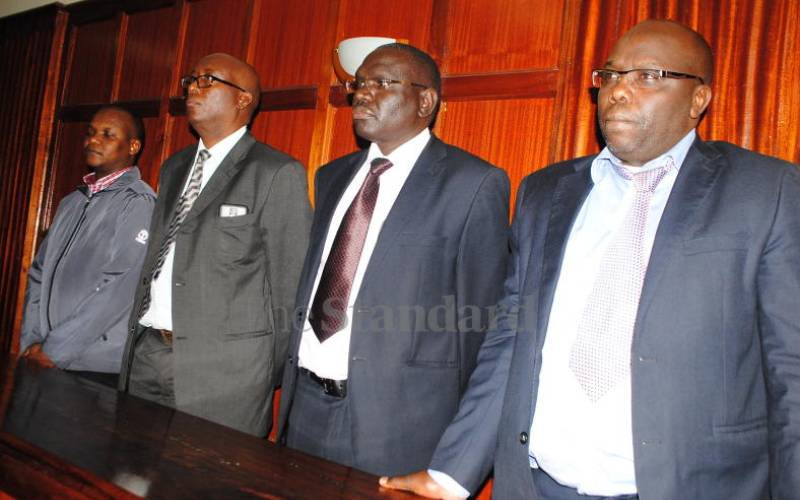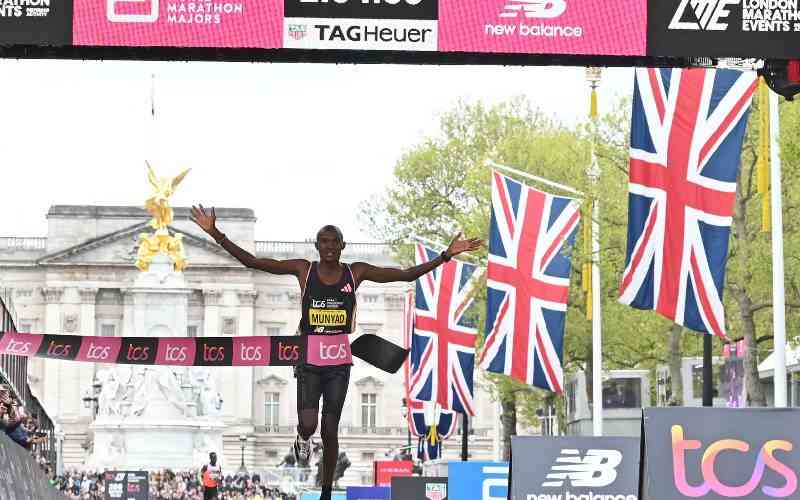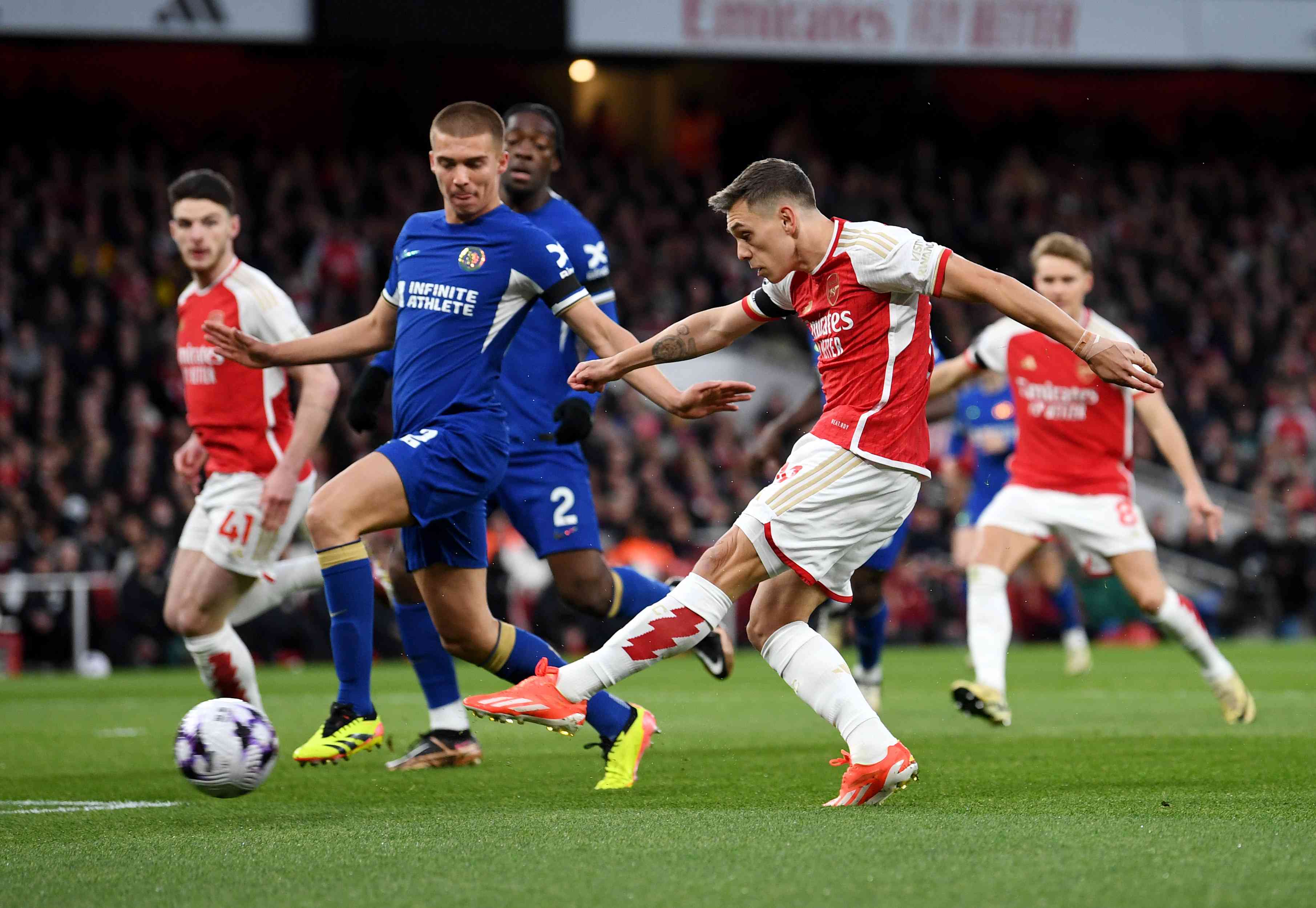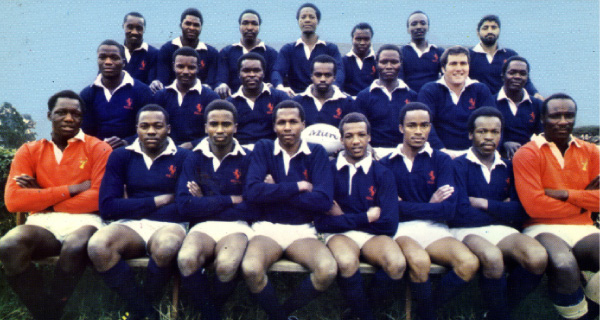 |
|
TOP: Kenyan team that played Zimbabwe in 1985 at the RFUEA ground - FRONT (from left): P Ngoga, D Wakhomba, P Nderi, P Belsoi, M Mwituria, K Kamau, D Sakari, J Owino; MIDDLE: M Muniafu, E Mureithi, E Vitisia, A MUtere, T Oketch, J Yakas, E Ayodo; BACK: P Odhiambo, P Magunga, A Kibisu, A Mwenesi, M Otieno, J Ayoki, R Sehmi; ABOVE: Jimmy Owino in a past tournament. [PHOTOS: OSCAR PILIPILI / STANDARD] |
By Gishinga Njoroge
At the dawn of Kenya’s 50thAnniversary of Independence, her rugby players are among the best in the whole world.
In a rollercoaster ride of history, the game witnessed decline from a colonial era boom to a fade just several years after, and then a remarkable renaissance, beginning in the Millennium, to the current staggering expansion.
Kenyan youth love rugby; especially seven-a-side rugby. The Sevens game, however, overshadows the full version of 15 players per team because the shorter type less infrastructure to develop and sustain.
Also, Kenya has performed so well -- such as being the fourth best at the 2013 Rugby World Cup Sevens in Moscow, Russia -- that her team capture the imagination of youth, players, people of Kenya and corporate sponsors.
During the Moscow World Cup, President Uhuru Kenyatta, a passionate player in his high school days, could not sit at State House but went out to join ordinary citizens at Impala Club, to watch the Kenyan team in “live” action from Russia.
The Kenya Sevens team competes as a chore team in the annual nine-round IRB [International Rugby Board] World Series. After many years on the circuit, the country is now experienced. Young players aspire to join the squad to enjoy the pleasure of seeing the world and make some money because the top group are semi-professionals, paid full-time monthly salaries from the team’s sponsorship.
The first corporate to finance the team was Sir Richard Branson’s Virgin Atlantic. Kenya Airways later took over and their logo adorns the Kenya Sevens shirt to date. Annually, the Kenya Sevens players have a ticket to ride and, in virtually every month in nine, leave on a jet plane to: Gold Coast [Australia], Dubai [UAE], Port Elizabeth [South Africa], Hong Kong [China], Tokyo [Japan], Wellington [New Zealand], Las Vegas [USA] and Edinburgh and London [UK].
But the Kenya XV suffers from a lack of enough international fixtures and is less active in a lean calendar. Everyone thinks their performance would improve if they had more international play. But in 2013 their achievement was probably their best ever.
They won the Africa Cup staged by CAR [Confederation of African Rugby]. This means, with the exception of South Africa, a Test playing nation, ranked in 2013 as No. 2 in the world, Kenya are the second best team in the continent.
In the CAR pecking order, Kenya are in Category ‘A1’ comprising: Kenya, Namibia, Zimbabwe and Madagascar. In relation to Kenya, the other African countries are in the following categories, in descending order:
Africa Cup ‘1B’: Uganda, Tunisia, Senegal, Cote d’Ivoire.
Africa Cup ‘1C’: Botswana, Morocco, Nigeria, Zambia, Mauritius, Swaziland.
Africa Cup ‘2 North’: Burkina Faso, Mali, Ghana, Togo, Benin and Niger.
Africa Cup ‘2 South’: Congo DR, Rwanda and Burundi.
In all-round rugby, Kenya is clearly a potential African rugby powerhouse, her reputation mostly hoisted right up there by their performing Sevens team.
Before Independence, the game was chiefly played by the colonial white people. But in 1962 on the eve of Independence, hitherto segregated public schooling was abolished and African pupils started attending the then privileged Government schools earlier meant for only students of European and other Western origins.
The African boys loved and learnt the game fast. They were soon to challenge for places in representative teams by the early 70s. The Kenyan and East African Select XVs played against top-class touring teams in the region from Britain and Ireland, France, Italy, Canada and the USA.
Some of the earliest talents to play for the local representative sides included: Ted Kabetu, George Kariuki, Chris Onsotti, William “Bully Bill” Okwirry, Frank Ojiambo, John Muhato, Nick Kado, Jackson and Walter Omaido, Philip Otolo, Johnny “Speedy” Akatsa and Dave Muraya.
With time, players of foreign origin diminished, while indigenous playing numbers increased and selection to the Kenya national team was restricted to citizens only.
Among the first all-citizen Kenya selection to play in a full international was the conquering team of 1979 which beat Zambia for the first time in the Copperbelt town of Luanshya. Jackson “Jacko” Omaido was skipper.
Thereafter, the biggest confrontations after 1982 were against the newly independent Zimbabwe who were then a supremely powerful team.
The history of Kenya Sevens best illustrates the successful road Kenya rugby has taken. And John Kagagi, an enthusiast of logging the details observes:
In the nascent post-independence days, the game was restricted to only a few schools. When a Kenyan social touring outfit, Watembezi Pacesetters RFC, burst onto the sevens scene in 1982, winning the Dubai Sevens on their first attempt, the entire team had been picked from ex-pupils [mostly then varsity students or recent graduates] from two schools: Nairobi School and Lenana School.
These institutions from the Colonial era were chief rivals. “Prince of Wales and Duke of York schools played their first ‘Old Firm’ game [between the two 1st XVs] in June, 1952,” wrote The Duke of York School’s I.C. Reid in the book, “Rugby Football in East Africa 1909-1959.”
Initially catering for white settler and colonial service children, both schools were “Africanised” after Kenya gained independence in 1963. The Duke of York was named Lenana School and The Prince of Wales became Nairobi School.
The two schools shared such a close sporting rivalry that the nicknames “Patch” (Nairobi School) and “Changes” (Lenana) were picked from the opposite sides of a Clarence Carter 1970 [Atlantic Records] funk music single which featured the blockbuster songs “Patches” and “Changes”.
Around Kenya’s independence in 1963, the administrators of rugby in the region, the Rugby Football Union of East Africa [RFUEA] started an annual schools’ sevens tournament, the RFUEA Sevens, boasting winners like Strathmore [a strictly ‘A’ level] College (1964), Kisii High (1967), [post-high school] East Africa Power and Lighting School (1970) and Rift Valley Academy (1988). In between it was won mainly by either Lenana or Nairobi.
In the late 60s, Lenana School started its own annual sevens competition, the John Andrews Memorial Sevens. The honours roll board was similar to the RFUEA 7s; Alliance High (1979) and RVA but mainly Nairobi and Lenana.
It came as no surprise that when the Kenya Sevens team took the field in Hong Kong for the first time against Malaysia in 1986, the squad list had the same Patch’/’Changes history:
Alma mater of pioneer Kenya squad at 1986 Hong Kong Sevens: • Jackson “Jacko” Omaido (Lenana), Cliff Mukulu (Lenana), Beth Alunga Omollo (Nairobi), Jimmy “Green” Owino (Nairobi), Pritt Nyandatt (Nairobi), Evans Vitisia (Lenana), Peter K. Belsoi (Lenana), Maina “Mad Max” Muniafu (Lenana), Danny Kimoro (Lenana), Andy Ahuga Mwenesi (Lenana).
By the mid-90s the RFUEA 7s had faded away, while the John Andrews 7s was limping severely, missing out competition in some years, with little momentum to support it.
A huge change in fortune came rugby’s way in 1990. The Kenya Secondary Schools Sports Association [KSSSA] agreed to take on a pilot rugby 15-a-side competition.
Earlier, the secondary schools and teachers’ college games, which were initially established after Kenya’s independence to nurture young athletes into succession of the likes of Kipchoge Keino, Amos Biwott and Ben Jipcho, were now lending a helping hand to rugby.
In an effort to revive schools sevens, the Kenya Rugby Union rugby development manager, Fred Ollows, convinced the KSSSA to add a pilot sevens tournament to the curriculum.
In 2005, Ollows made a presentation to the governing council of the Ministry of Education and the sport was accepted, with technical assistance provided by the KRU.
“We received plenty of support from the KSSSA executive committee,” recalls Ollows, “Benjamin Njoka, David Ngugi, George Omondi and Benjamin Kitilit were all eager to get the rugby show on the road.”
“Our sports talent is a national resource,” said KSSSA secretary David Ngugi at the time. “Some schools could not even afford playing kit or technical coaching at one stage, but sponsors came in and leveled the playing field by supplying playing kit to all the schools. The KRU provided technical assistance. Players are no longer intimidated on this stage, wherever they come from.”
These days an equal rugby playing ground for the whole country is indeed a great network to tap into. With an annual budget of over Sh190 million, the KSSSA is one of the largest sports organisations in the country.
The greatest benefit to any game is the reach for talent that the competition has allowed.
“In the first official competition, we identified Horace Otieno from Nyabondo Secondary School,” recalled Ollows. “In 2008, Willy Ambaka, a 2013 IRB Sevens Player-of-the-year nominee, was convinced to leave playing basketball and soccer and concentrate on rugby,” said Twaha Mwatsau, a rugby trainer in Mombasa.
“Ambaka was identified as a talented player when Dr Aggrey High School made their maiden appearance in a KSSSA divisional competition in Wundanyi,” recalled Robert Ndambo, a teacher who took the game to Taita Taveta from Mombasa.
Later that year Ambaka would represent Coast Province in the Safaricom Sevens Schools competition, another stepping stone to national representation. Another hot talent, Dennis Ombachi, who would miss the 2013 Sevens World Cup because of injury, was discovered at Kiambu High, the extract from Kagagi’s report concludes.
The squad of 12 that would represent Kenya in the 2013 Rugby World Cup Sevens would incredibly be from eight different counties. The squad was:
Kenya squad for 2013 Rugby World Cup Sevens: Andrew Amonde (Kisumu Boys High) Kisumu County, Willy Ambaka (Dr Aggrey High, Wundanyi) Taita/Taveta County, Eden Agero (St Mary’s, Yala) Siaya County, Patrice Agunda (St Mary’s, Yala) Siaya County, Lavin Asego (St Mary’s, Yala) Siaya County, Felix Ayange (Kakamega High) Kakamega County, Horace Otieno (Nyabondo Secondary) Kisumu County, Collins Injera (Vihiga High) Kakamega County, Biko Adema ( St Mary’s, Nairobi) Nairobi County, Michael Wanjala (Bungoma High) Bungoma County, Oscar Wanjala (Kijabe High) Kiambu County, Humphrey Khayange Emonyi (St Peter’s High, Mumias) Kakamega County
The booming growth of rugby in the past few years is nowhere near its peak. At the onset of the mid-1970s, playing numbers and clubs had dwindled, to almost extinction, following the exit of former colonials and ex-patriots.
In 1976, there were only three clubs, Impala, Nondescripts and Kenya Harlequins, playing league rugby and it had narrowed down to a Nairobi District Championship [NDC].
In fact Nakuru Athletic Club and Kitale Club only formed a combined team, Kituru, to take part in the annual Enterprise Cup. The other participants in that knock-out competition surviving to date were Mombasa Sports Club and a side from Uganda, Kampala RFC, and Tanzanian side, Dar es Salaam.
Then 1977 saw the entry in league rugby, for the first time, of University of Nairobi’s Mean Machine who duly shockingly won it. Many of the Mean Machine players of ’77 grouped to launch Mwamba RFC in 1978 and for the next decade, Mean Machine and Mwamba became the evangelists of the expansion of Kenya rugby.
That has continued to bear fruit but the speed has been accelerated in the tenure of the Kenya Rugby Union [KRU] chairman, Mwangi Muthee, a long-time chairman of Mwamba who played varsity rugby at UoN and the University of Newcastle Upon Tyne.
Now there is excellent spread of the game to secondary -- and even primary --- schools right across the country and slowly sub-unions are being set-up by county “conferences” to compliment the KRU in the administration of the game.
When the 2013/14 season kicks off today, 14 teams will be playing in the premier Kenya Cup League and in all, 62 club and institutional teams will be involved in various leagues.
 The Standard Group Plc is a multi-media organization with investments in media
platforms spanning newspaper print operations, television, radio broadcasting,
digital and online services. The Standard Group is recognized as a leading
multi-media house in Kenya with a key influence in matters of national and
international interest.
The Standard Group Plc is a multi-media organization with investments in media
platforms spanning newspaper print operations, television, radio broadcasting,
digital and online services. The Standard Group is recognized as a leading
multi-media house in Kenya with a key influence in matters of national and
international interest.
 The Standard Group Plc is a multi-media organization with investments in media
platforms spanning newspaper print operations, television, radio broadcasting,
digital and online services. The Standard Group is recognized as a leading
multi-media house in Kenya with a key influence in matters of national and
international interest.
The Standard Group Plc is a multi-media organization with investments in media
platforms spanning newspaper print operations, television, radio broadcasting,
digital and online services. The Standard Group is recognized as a leading
multi-media house in Kenya with a key influence in matters of national and
international interest.



